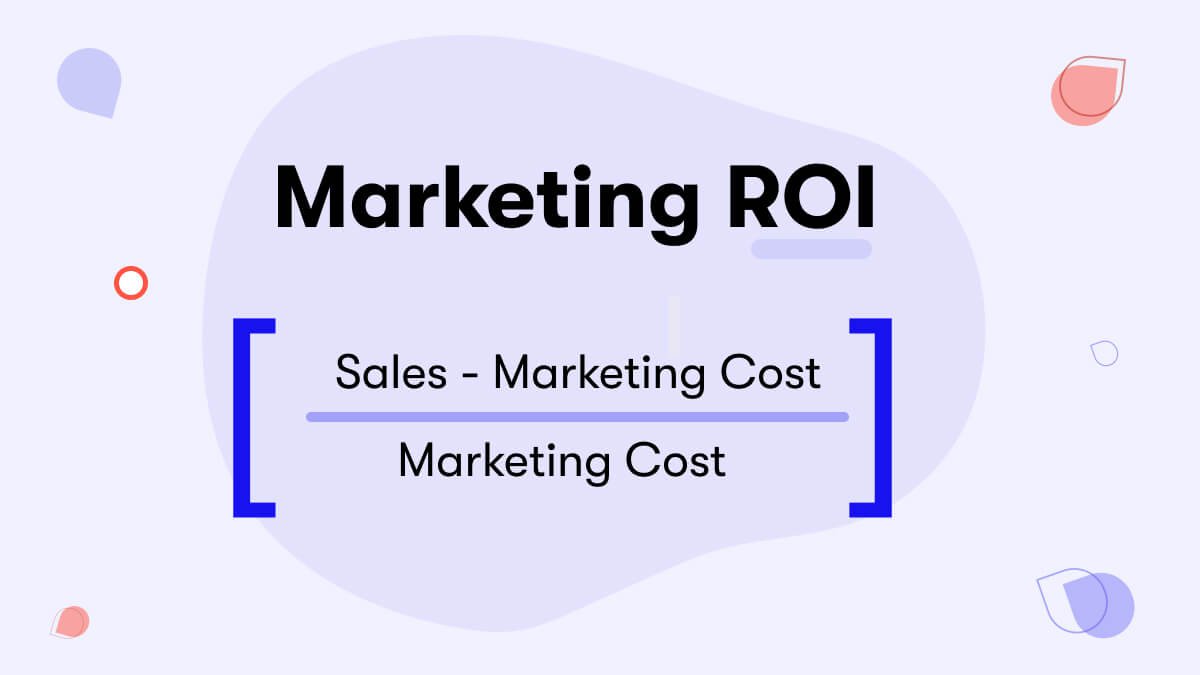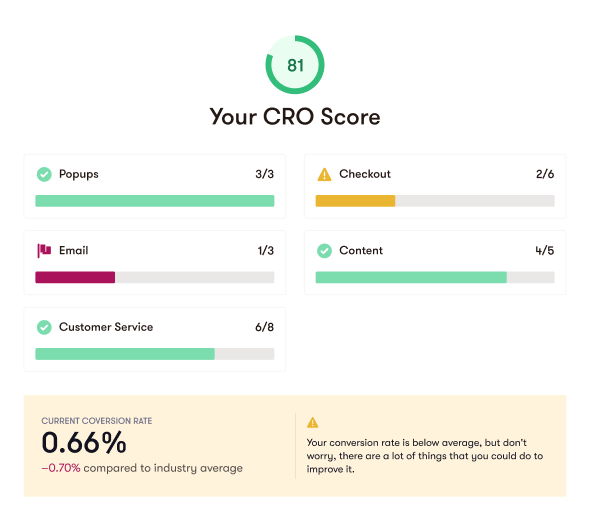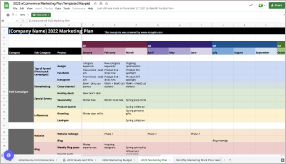
Marketing ROI: What It Is, How to Calculate and Maximize it in 2023
Want to scale your marketing campaigns? Get more sales? You need to track your marketing ROI. Here's what it is, how to measure it, and why it's important.
DOWNLOAD TEMPLATEWhy does everyone talk about winning marketing strategies? And what's a winning marketing strategy anyway? It all comes down to your return on investment (ROI).
One of the essential parts of any marketing strategy is to assess its performance, impact, and profitability to determine whether or not the marketing efforts are generating a sufficient number of leads and sales.
By calculating the ROI of your digital marketing campaigns, marketers can identify what’s working and what’s not. This enables them to conceptualize, implement, and execute a data-driven marketing plan that works.
In this post, we will help you decide which marketing strategies are best for your business by first explaining what marketing ROI is, how to calculate it, and how to improve it over time.
What is marketing ROI?
Marketing ROI refers to the profit earned from every dollar a business spends on marketing efforts. It's used to quantify and justify how marketing programs and campaigns generate revenue for the business. ROI is short for return on investment and in this case, it measures the money the business spends on marketing activities versus the revenue generated from those marketing activities.
A positive return on investment indicates that you are marking more than you are investing. Meaning - the money you spend attracting your target audience with your marketing efforts is more than the cost of the campaign itself. Conversely, a negative return on investment is the opposite, meaning marketing expense is more than earnings.
[Banner][Looking to Scale Your Marketing Campaigns?][Work with an Expert Marketer. Hand-picked marketers with proven experience, hire in 72 hours.][Get Started][https://www.mayple.com/welcome-v4/?utm_content=blog-banner-marketing-roi][orange]
How is marketing ROI used by companies?
Businesses need to regularly calculate their return on marketing investment for every campaign in order to make informed decisions and optimize marketing efforts. Having an in-depth knowledge of the return on investment generated through campaigns is imperative because it helps with the following:
Justify marketing spend
Most Chief Marketing Officers (CMOs) have listed allocating resources and budgets for marketing campaigns and efforts as top priorities.

However, to ensure budget and resources for future campaigns continue to flow in, the current marketing expenses require justification at the executive level.
To make this happen, marketers must accurately calculate the return on investment of all marketing efforts. For example, they should identify whether the advertisements are driving conversions and at what ROAS to allocate budgets properly.
Measure campaign success
The best marketing team will only be as successful as its ability to measure campaign success and establish a baseline for future efforts. An accurate calculation of the marketing ROI enables marketers to do both. Also, analyzing the data helps marketers to gauge their success and adjust efforts to maximize impact quickly.
Allocate marketing budget
There are hundreds of individual marketing channels a brand could use and it's often difficult to decide what to throw marketing dollars towards. A good understanding of which of these platforms generates the most revenue is necessary for allocating the marketing budget.
Businesses should use analytics software (like Google Analytics) to calculate not only the ROI of each channel, but also the customer lifetime value, conversion rate, and the number of quality leads.

Competitive analysis
Another way brands use mROI is to compare themselves to their competitors. It's difficult to track competitors' marketing performance but teams can estimate based on different cues.
Tracking competitors' marketing ROI helps marketers understand how their business performs within their specific industry or niche and adjust their efforts accordingly and make better strategic decisions.

How to calculate marketing ROI
To calculate marketing ROI, you need to subtract the marketing cost from your sales growth and divide it by the marketing cost.
So, if sales revenue is $2,000 and the marketing campaign cost is $200, then the simple ROI is 900%. (($2000-$200) / $200) = 900%.
It’s important to note that this formula assumes that all sales growth is linked to marketing efforts. Therefore, marketers should account for organic sales to generate a more realistic view of marketing impact and ROI.
(Sales Growth - Organic Sales Growth - Marketing Cost) / Marketing Cost = Marketing ROI
Let’s look at some key factors to keep in mind while calculating your marketing ROI.
- Total Revenue: Helps in getting a clear overview of marketing efforts and is ideal for strategic social media planning, budget allocation, and overall marketing impact.
- Gross Profit: Helps understand the total revenue produced by the marketing efforts concerning the cost of production or delivery of goods and services. To do this, add the following to the marketing ROI formula: = (Total revenue - the cost of goods to deliver a product).
- Net Profit: Helps in identifying the impact of marketing efforts on the net profit. To do this, add the following to the marketing ROI formula: = (Gross profit - additional expenses).
What is a good marketing ROI?
The shortest and most straightforward answer to this question is that a good marketing ROI is a ratio of 5:1 - or making five dollars for every dollar you spend.
A marketing ROI of 10:1 is considered exceptional. This is because you're turning a profit, even when you account for external variables.
Anything below the 2:1 ratio is barely profitable because after factoring in the business expenses, which will likely reduce it to a 1:1 ratio. The marketing ROI calculation assumes direct investments but only usually includes business costs like salaries and office space that were also necessary to make that campaign happen.
It's important to note that a “good marketing ROI” is entirely subjective. It depends on your niche, industry, and use case. For example, some industries are more saturated or competitive and require large budgets to produce some profit.
Our advice: Don’t make ROI your end-all-be-all metric. Instead, stick to your business goals and key performance indicators (KPIs) — one of which might be ROI.
Challenges of measuring marketing ROI
Measuring ROI is not all rainbows and unicorns. Here are some challenges to consider:
Measurements are simplistic
Marketers must get a clear and consistent sales baseline to measure against. Also, ROI measurements should take for external factors that impact campaign success, including weather, marketing industry trends, events, supply chain issues, etc.
Cross-channel landscape
Campaigns aren’t run on a single channel. They often use various online and offline channels simultaneously. Therefore, focusing marketing ROI measurements on a single channel will only feed marketers with a tiny piece of the overall marketing impact data.

Pro tip: Make sure that you're using cross-channel reports, especially when you use an advertising agency for one or several of your channels, in order to see the entire picture.
Multiple touchpoints before purchase
It usually takes 6-10 touch points on average before a potential customer makes a buying decision. So a marketing team needs to understand the relationship between these touchpoints in the sales funnel and use a multi-touch attribution model, measuring direct and indirect relationships.

For example, a user might click on a Facebook ad, then read a blog post, and only convert 6 months later by googling your name. That sale is going to show up as "organic search" when in fact it's probably a combination of Facebook Ads and content marketing.
Tips on improving your marketing ROI
Let’s look at some tips you can use to optimize your future marketing efforts to improve marketing ROI:
Defining clear goals
The first step is setting clear goals for every marketing channel.
- What are you looking to achieve?
- What are your marketing objectives?
- Are you after MQLs? SQLs?
- Is your goal to get more brand awareness?
- Are you trying to increase social media engagement?
Take your goal into consideration when you work on improving your ROI because it's not always linear. There are a lot of different touchpoints to consider and ultimately there are often a lot of interactions between your channels.
Determining cost
Next, you have to look at all your various costs to get a clearer measurement of ROI. These costs could include:
- Software and website setup (domain names, an SSL certificate, hosting)
- Marketing efforts (CRM for customer relationships, marketing spending)
- Personel (full-time employees, marketing consultants, and agency fees)
- Overhead (distribution channels, inventory, storage)
- Production costs
If you have a brand new marketing channel that you're just developing you shouldn't lump in all the salaries and overhead costs into the calculation. Give it a few months (6-12) to really reach marketing efficiency and then see how it compares.
Leverage marketing analytics tools
Focus on the right marketing analytics tools and strategies with the capability to unify disparate attributions alongside online and offline measurements. With the right tools and processes, marketers will have clearer insights to use in their formulas—leading to more efficient and accurate ROI measurement.
Examples of marketing ROI in action
Let’s see some examples of marketing ROI of some most common digital marketing channels.
Email marketing
Here's an example of how a company might measure email marketing ROI.
A local cat daycare offers a weekly e-newsletter to customers who sign up on their website. A cat food company pays them $100 to place an ad that links to their purchasing page for their new products.
Because of the tracking URL, the cat food company can see that 50 visitors came onto their product page. Of those 50 visitors, 20 placed the cat food in their cart, and 17 purchased it.
That ROI formula would look like this:
[((20 x .85 x $20) - $100) ÷ $100] x 100 = 240%
After determining how much profit they gained from the newsletter, the cat food company might continue to place ads in that newsletter or want to branch out to other cat-related emails.
Written content
A law firm that focuses on real-estate-related cases wants to increase its clientele. So they created five blog posts about tenants' rights and included tracking links to a landing page where visitors can request free legal consultation.
They spend $900 on blog creation and $100 for promotion. The posts result in eight leads -- four of which become clients. As a result, the firm made an average of $2,000 per client.
Their ROI formula would look like this:
[((8 x 0.5 x $2,000) - $1,000) ÷ $1,000] x 100 = 700%
If the firms like this strategy but wish to increase their ROI, they could create a video or churn out posts at a higher frequency.
Paid social media promotion
A lifestyle publication intends to boost its web subscriptions, which cost $10/month. So they decide to offer a one-month free trial to pull in leads. They create a post about the Instagram trial, including a tracking URL that leads to the free-trial landing page.
Having a $25/day budget, they boost the post for four days. During this period, they manage to attract 100 visitors and 20 free-trial subscribers. Of the 20, four become paid subscribers.
Their social media ROI formula would look like this:
[((20 x .2 x $10) - $100) ÷ $100] x 100 = -60%
If the publication has yet to give up on a boosting strategy, they might try paid promotion on another social platform next time.
The Bottom Line
Marketing plays an essential role in most businesses and can easily return many times over what it costs.
But, to make the most of your marketing expenditure, you must know how to measure its results.
Out of all the metrics, your marketing return on investment is one of the most significant for most businesses. Because the results of any campaign take time to appear, it is ideal that you run your calculations using sales growth minus the average growth throughout the entire campaign.
Remember, if the ROI isn’t there after a few months, it might be the wrong campaign for your target audience and market.
[Banner][Looking to Scale Your Marketing Campaigns?][Work with an Expert Marketer. Hand-picked marketers with proven experience, hire in 72 hours.][Get Started][https://www.mayple.com/welcome-v4/?utm_content=blog-banner-marketing-roi][blue]
.jpg)
















